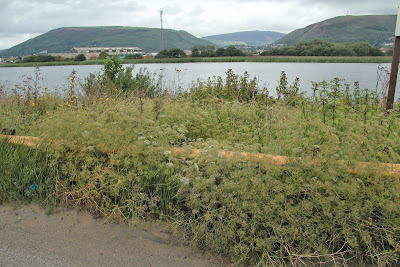Miscellaneous observations from the wonderfully diverse habitat
s at Crymlyn Burrows during a morning visit by Matt Pickard and myself included drifts of Goldenrod (Solidago virgaurea), this species being very abundant on the landward dune ridges where it grows alongside Devil's-bit Scabious (Succisa pratensis). The two species proved to be very attractive to a wide range of invertebrates. Unfortunately we failed to relocate Field Wormwood (Artemisia campestris) seen a few weeks previously by Charles Hipkin and Penny Neyland, this now one of Glamorgan's most threatened plants, with invading scrub due to lack of management being the principal cause of its steady decline.
On the plus side the discovery of Star-wort (Cucullia asteris) larvae feeding on Goldenrod was a highlight. I am aware of only four other post-2000 records of this Nationally Notable moth in Glamorgan, all just singletons of adults, so the discovery of a breeding population is very significant.
Bumblebees were generally rather scarce, but three noteworthy species were recorded,
Brown-banded Carder Bumblebee (
Bombus humilis) [a BAP priority species],
Red-shanked Carder Bumblebee (
B. ruderarius) and
Heath Bumblebee (
B. jonellus).
.jpg) |
| Heath Bumblebee on Goldenrod |
Alien plants are a prominent feature in parts of Crymlyn Burrows, for example
Early Goldenrod (
Solidago gigantea) which form extensive stands along with other species such as
Soapwort (
Saponaria officinalis), but perhaps most worryingly of all
Sea Buckthorn (
Hippophae rhamnoides), which is now very prominent in some areas. Patches of of
Japanese Knotweed (
Fallopia japonica) and
Japanese Rose (
Rosa rugosa) are not infrequent on the more open dunes and there is patch of the rather incongruous is
Orange-peel Clematis (
Clematis tangutica), which proved to be very attractive to Brown-banded Carder Bumblebees. This striking plant was first noted by Charles & Hilary Hipkin in 1998 and I assume the ~5m x 4m clump at SS717927 shown to me by Matt today is the same?
 |
| large drift of Early Goldenrod about to burst into flower |
+31aug13+(10a).jpg) |
| Orange-peel Clematis |
+31aug13+(08a).jpg) |
Orange-peel Clematis seed head...
...perhaps the inspiration for Dr Seuss's Truffula Trees? |
Additional to the issues of scrub encroachment and alien invaders, the site will also see changes brought about by the university and proposed tidal lagoon developments. Dune habitats are dynamic and they can show a surprising level of resilience, however, maintaining the biological interest of the site will be a major challenge faced by those involved in the site's future management.
.jpg)

+31aug13+(10a).jpg)
+31aug13+(08a).jpg)


+31aug13+(1a).jpg)







+(03a).jpg)
+(05a).jpg)
+(09a).jpg)
+(7a).jpg)
+10aug13+(1a).jpg)












